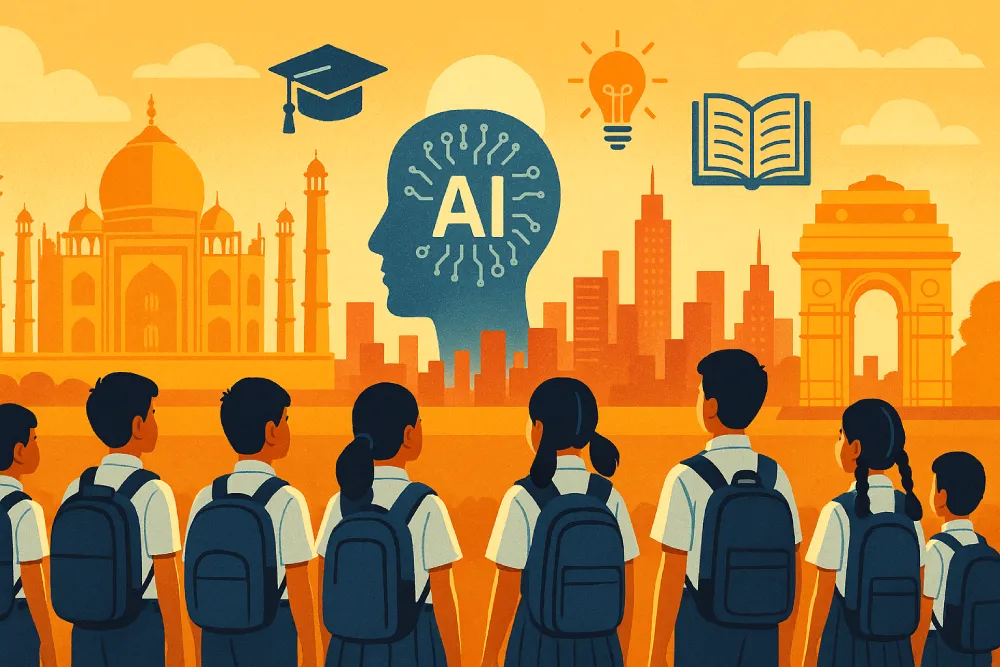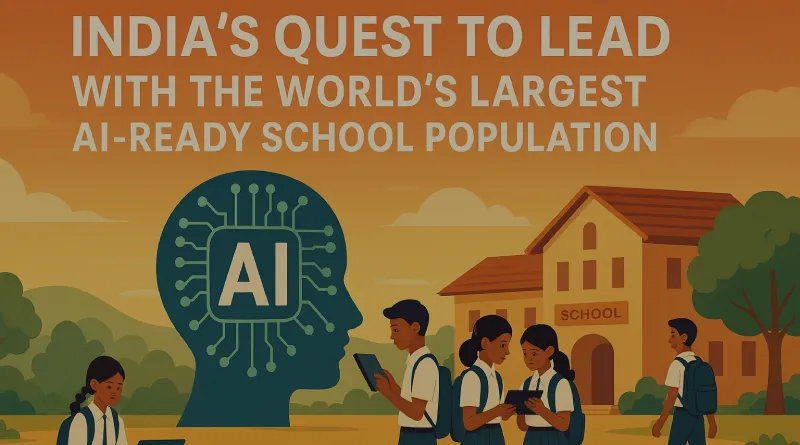India’s Quest to Lead with the World’s Largest AI-Ready School Population
India is on the cusp of a transformative educational revolution, aiming to create the world’s largest network of AI-ready school students. As announced by Union Minister of State for Skill Development and Entrepreneurship (MSDE) and Education, Jayant Chaudhary, during the 10-year celebration of the Skill India Mission at BharatSkillNxt 2025, this ambitious vision is set to materialize within the next six months. By integrating artificial intelligence (AI) into school curriculums, India is not only preparing its youth for a tech-driven future but also positioning itself as a global leader in AI education. This article explores how India is achieving this goal, the initiatives driving this change, and the unique local context shaping this journey.
A Vision for a Tech-Savvy Future
One project that has been central to the attempt to empower the youth in India with the help of skill development is the Skill India Mission that was unveiled in 2015. During one of his meetings, the Minister Chaudhary pointed out that the schoolgoing population of India, the number of which globally can create a formidable message soon, can benefit the world by practicing the use and application of AI in an active manner. This is our bold and tech-savvy future we are creating, stated by him. This vision falls in line with that of Viksit Bharat 2047, which is a plan to make India a developed country with a workforce that is skilled and prepared ready to go into the future.
Use of AI in education is a strategic approach towards the current and future workforce generation in the face of the global demand of AI and data science workers, which are estimated to reach more than 1 million workers in India by the year 2024. India wants to equip a new generation of students with AI literacy so that young people can transform innovation in many fields, including technology but also healthcare and other sectors.
The SOAR Program: A Game-Changer for AI Education
An important cog of this program is the Skilling for AI Readiness (SOAR) scheme, which the MSDE released, to integrate AI learning into schools programs between Classes 6 and 12. Among the most important topics, SOAR includes the basics of AI, generative AI, ethical use of technology, cybersecurity, and career prospects. The idea of this program is to make sure that students do not only get to know about AI but to work with it in practice and develop hands-on skills that industry demand and require.
This aspect is supported by collaboration with world leaders in technology such as Microsoft and Intel that have linked up with education boards namely the Central Board of Secondary Education (CBSE) to come up with detailed AI curriculum. As an example, CBSE has made AI become the option in Classes 9-12 and collaborates with IBM to launch the SkillsBuild Program, which has generative AI orientation lessons. More than that, even the Council for the Indian School Certificate Examinations (CISCE) is also introducing robots and AI into its syllabus beginning in the 2025-26 academic year.

Local Context: Bridging Gaps in a Diverse Nation
The Indian socio-economic and multi-lingual background comes with challenges and opportunities of AI education. A large population of more than 1.4 billion with a high ratio of rural citizens will warrant equal opportunities in accessing Artificial Intelligence learning. The National Education Policy (NEP) 2020 is central in this regard, which lays a particular focus on digitalized literacy, code, and computational thinking at all levels. NEP 2020 will ensure that all learners are included and have access to learning, especially the rural localities and marginalized groups, by making vocational learning a mainstream part of the curriculum and using AI.
Such programs as AI for India 2.0 program introduced by MSDE in cooperation with GUVI, and approved by the National Council for Vocational Education and Training (NCVET) mitigate the language barrier by providing training in AI in 9 Indian languages. This also guarantees the non-English speaking region that the students will be able to access the best skills and be inclusive.
In addition to that, local education issues are addressed by AI-based tools. As an instance, the Tamil Nadu e-Governance Agency (TNeGA) has already introduced an attendance system based on facial recognition by utilizing deep learning, thereby eliminating the tiresome process of manual marking of attendance in the state-owned schools of Tamil Nadu. In a related development, Andhra Pradesh has a Microsoft partnership that uses machine learning to model the probability of student dropout, and to intervene to prevent student dropouts to solve high dropout rates in underserved regions.
Unique Insights: Redefining Education for the AI Era
Teaching AI is not only about developments in technology but also about making a culture of innovation and ethical responsibility to others. The NEP 2020 places significant focus on AI-related ethical concerns, supplying students not only with tech-savviness but also with social responsibility, so that the next generation of technology users is safe not only in terms of technology but also in terms of ethics.
AI-driven education in India is driven by personalized learning unlike in traditional education systems which are usually based on rote learning. With reinforcement learning, EdTech startups such as Jungroo Learning are making improvements to ensure learning by customizing educational content to suit individual student requirements. Such a change towards adaptive learning instead of the one-size-fits-all strategy is transforming the nature of education delivery, rendering it more fascinating and productive.
Moreover, public-private partnerships in India are a distinguished characteristic. The partnerships with the international technology giants and domestic schools like the Indian Institutes of Technology (IITs) and Indian Institutes of Management (IIMs) facilitate the fact that the learning process in the field of AI is in line with the needs of the industry. Internships and real-life projects also take place in such partnerships and thus provides students with practical experience.
Challenges and the Road Ahead
With these developments, there are still difficulties. In India, there is a gap of 1 million teachers, especially in rural India, which makes it difficult to carry out tech-driven education. There is also the digital divide which is the lack of access to devices and an internet connection in rural areas, which is a challenge. Entrepreneurs, such as Digital India, or cooperation with technology corporations will be used to address this gap and offer schools with low resources access to AI.
Another important area is teacher training. Efforts such as the CBSE-Microsoft partnership that went on to train 1,000 teachers on AI-based tools in 2019 are headed in the right direction, but we need to consider expanding such initiatives nationwide.
Conclusion: A Global Benchmark in AI Education
India’s ambition to lead with the world’s largest AI-ready school population is a bold and achievable goal. Through initiatives like SOAR, NEP 2020, and strategic partnerships, the country is laying a strong foundation for a tech-driven future. By addressing local challenges, fostering inclusivity, and emphasizing ethical AI use, India is not only preparing its youth for global opportunities but also setting a benchmark for other nations. As Minister Chaudhary aptly stated, this is about building a Kaushal Bharat (Skilled India) for a Viksit Bharat (Developed India), where every learner is empowered to thrive in an AI-driven world.
Disclaimer
The information presented in this blog is derived from publicly available sources for general use, including any cited references. While we strive to mention credible sources whenever possible,
Web Techneeq – Web Design Agency in Mumbai does not guarantee the accuracy of the information provided in any way. This article is intended solely for general informational purposes. It should be understood that it does not constitute legal advice and does not aim to serve as such. If any individual(s) make decisions based on the information in this article without verifying the facts, we explicitly reject any liability that may arise as a result. We recommend that readers seek separate guidance regarding any specific information provided here.

